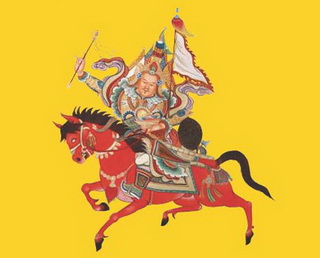 In Tibetan literature, the Epic of King Gesar represents the highest achievement. It is the longest epic in the world, the length even exceeding the total of the five most famous epics in the world, that is, Babylonian Gilgamesh, Greek Odyssey and Iliad, Indian Ramayana and Mahabharata.
In Tibetan literature, the Epic of King Gesar represents the highest achievement. It is the longest epic in the world, the length even exceeding the total of the five most famous epics in the world, that is, Babylonian Gilgamesh, Greek Odyssey and Iliad, Indian Ramayana and Mahabharata. King Gesar is a heroic epic created collectively by the Tibetans during the 11th to 13th century. As the beloved king of the ancient Tibetan kingdom of Ling, Gesar was believed to be the son of God of Heaven. Gesar and his followers bravely and resourcefully struggled against evil forces and conquered the kingdom of demons with great wisdoms and super natural power, bringing peace and happiness to his people. The great hero and his brave army are kept alive in the imaginative retelling of the epic. The epic contains a lot of great poetry and vivid description of the characters. It sings high praise for Gesar's efforts to aid the weak and poor, to defeat the demons and to benefit the common people. It reflects the wishes of the ordinary Tibetans to fight against the evil and struggle for peace and freedom.
Theme of the epic, King Gesar
The epic, King Gesar, was adapted according to legends of this real hero. His lifetime serves as the source of the great work. The theme of the epic centers on the life, deeds, and merits of the divine hero, Gesar, whose mission from heaven to this world was to rescue his loved ones from earthly calamities, unify disparate tribes, defeat ravaging monsters, and aid the weak and the poor.
Artistic Achievements in King Gesar
The epic of King Gesar is a great work of both realism and romanticism. All the characters in the epic, no matter positive or negative, male or female, young or old, are described in such a vivid way that they are kept alive in the telling and singing of the epic. Gesar is a great ballad - epic about an ancient Tibetan hero; it also tells us much about ancient Tibetan society, including war, production, living styles, nationality, religion and morality. Thus it is a virtual encyclopedia about the lives of ancient Tibetans, and enjoys high aesthetic and academic value.

 China Tours
China Tours Tibet Tours
Tibet Tours China Theme Tours
China Theme Tours Off The Beaten Track
Off The Beaten Track Yangtze Cruises
Yangtze Cruises China Trip Planner
China Trip Planner Travel Agents
Travel Agents China Tours
China Tours Tibet Tours
Tibet Tours China Theme Tours
China Theme Tours Off The Beaten Track
Off The Beaten Track Yangtze Cruises
Yangtze Cruises China Trip Planner
China Trip Planner Travel Agents
Travel Agents


 0086-28-85711328
0086-28-85711328 0086-28-85546015
0086-28-85546015






 In Tibetan literature, the Epic of King Gesar represents the highest achievement. It is the longest epic in the world, the length even exceeding the total of the five most famous epics in the world, that is, Babylonian Gilgamesh, Greek Odyssey and Iliad, Indian Ramayana and Mahabharata.
In Tibetan literature, the Epic of King Gesar represents the highest achievement. It is the longest epic in the world, the length even exceeding the total of the five most famous epics in the world, that is, Babylonian Gilgamesh, Greek Odyssey and Iliad, Indian Ramayana and Mahabharata.